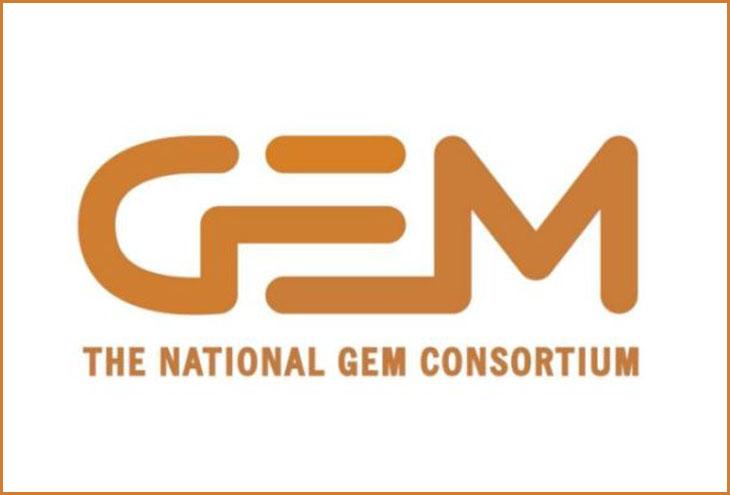A Q&A with Dr. Michael “Mike” Smith
What is the National Gem Consortium and how does it benefit students?
The university and employer members of the National GEM Consortium (GEM) provide a large network, financial support, and expert knowledge to help ensure student success in competitive academic and professional environments. GEM recruits underrepresented students looking to pursue master’s and doctoral degrees in applied science and engineering, and matches their specific skills to the specific technical needs of GEM employer members. Unlike many other fellowship programs, GEM offers internship opportunities through their fellowships. Master’s degree candidates can participate in two internships and PhD candidates can participate in one internship.
How many GEM partners are there?
Within the GEM Consortium are 150 university and employer members, including industry and national laboratories, that come together to support students in graduate school. While they share different audiences, they have a common mission and objectives. GEM also has several community STEM partners, such as AISES, NSBE, SACNAS, SHPE, and SWE.
Intel has been engaged with GEM for more than 30 years and is the leading employer sponsor of GEM Fellowships. Not only has Intel been a big supporter of fellowships and internships, the company has supported GEM in many other ways such as funding the National GEM Grad labs and hosting symposiums and many other programs.
What is the application process?
GEM is a competitive fellowship program. GEM’s application process mirrors that of graduate school, requiring a statement of purpose, recommendations, transcripts, and resume or curriculum vitae. The number of full fellowships depends on the GEM Consortium employee members.
Minimum requirements:
GPA of 2.80 for master’s programs; GPA of 3.0 for PhD programs.
U.S. citizen or permanent residents. (If you are an international student, still apply; other institutions review GEM applicants and may offer fellowships via the schools.)
What does GEM provide in fellowship funding?
Master’s Program:
• $16,000 — total stipend over the entire Master’s program (remitted in payments by terms to the matriculating GEM Member University)
• Full tuition and mandatory fees at GEM Member University (if tuition is covered by the school, the student may apply that to the stipend allocation)
PhD Program:
• $16,000 stipend applied to first academic year
• Additional stipend (assistantships, grants, other stipend dollars) support from GEM Member University
• Full tuition and mandatory fees up to the fifth year of the PhD program
If tuition is covered by the school, the student can put that $4,000 on stipend.
When can students apply?
Students can begin the application process for the GEM Fellowship now through November 13, 2020. Please visit www.gemfellowship.org to begin the application process and for more detailed information on the fellowship program.
What if a student has several scholarships and is fully supported?
GEM is a stackable fellowship, which means that awardees can use the GEM Fellowship with other funding sources. Some fellowships are not stackable; in those cases, GEM can defer the awarded scholarship. For example, if you have a four-year, fully fundable fellowship with everything paid, you would not need GEM funding during those years, so GEM can hold your spot until you need funding in the fifth year. (Please note: an AISES member can apply and receive both the Intel AISES scholarship and the GEM fellowship simultaneously.)
Any tips?
1. Don’t count out GEM even if you have full funding.
2. Create relationships with GEM employers and university sponsors. These entities select who will receive the funding. Any opportunity you have to engage, do so. Visit their booth at national conferences or at your school and introduce yourself; tell them you are interested in going to grad school.
3. You must communicate.
4. Be open to unique opportunities that you may not otherwise select. A number of companies may be in areas where you do not want to be. But I recommend that you reconsider them because it is a unique, finite experience.
5. Take the GRE during the spring semester of your junior year and a second time during the coming fall semester, if desired. The goal is to achieve a higher score each time you take the exam.
6. When applying for GEM Fellowships, be sure to make your statement of purpose personal. Include information about yourself and your reason for wanting an advanced degree, and any previous research experiences that support your graduate degree goals.
Have AISES members had GEM Fellowships over the years?
GEM has been connected with AISES for many years. Each year, up to 4 percent of GEM Fellowship applicants self-identify as Native American. Sandra Begay of Sandia National Laboratories and former executive director and board chair of AISES is one notable GEM Fellow who is also a current AISES member and Sequoyah Fellow.
What is a GRAD Lab, and how do students participate?
Getting Ready for Advanced Degrees (GRAD) Lab offers underrepresented students exposure to the benefits of research and technology careers during a highly interactive, one-day event. GEM has been offering undergraduate students the opportunity to attend GRAD Labs since 2006 at conferences and select colleges. This year, due to the COVID-19 pandemic, GEM is developing a virtual model for their national GRAD Lab. They will be hosting a hybrid version of in-person and virtual. Check out our website for dates of future GEM GRAD Lab events.











